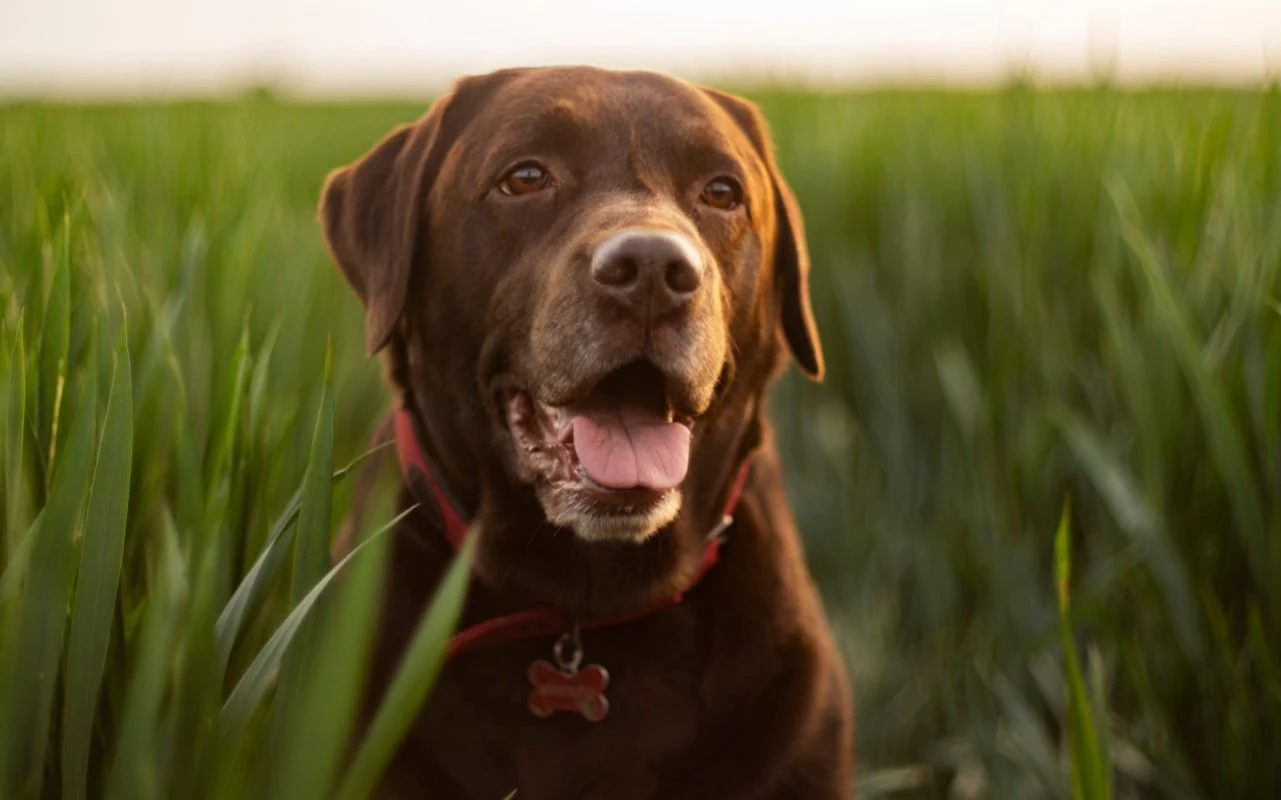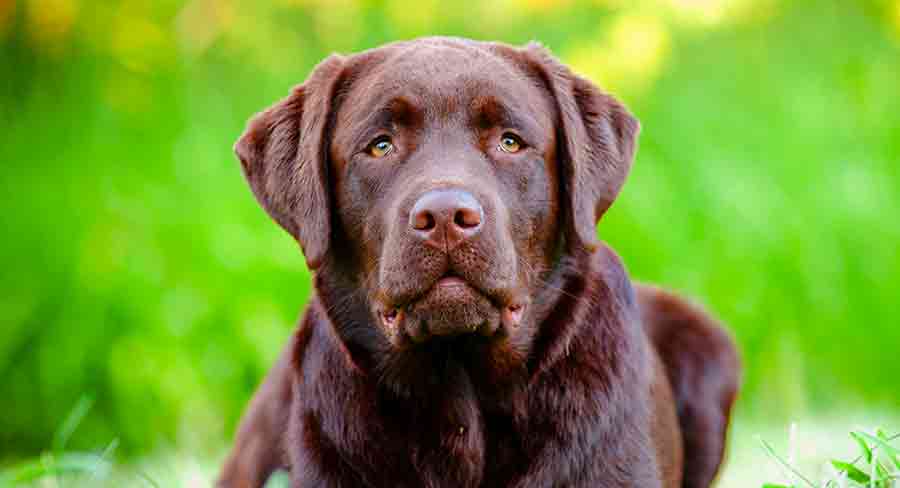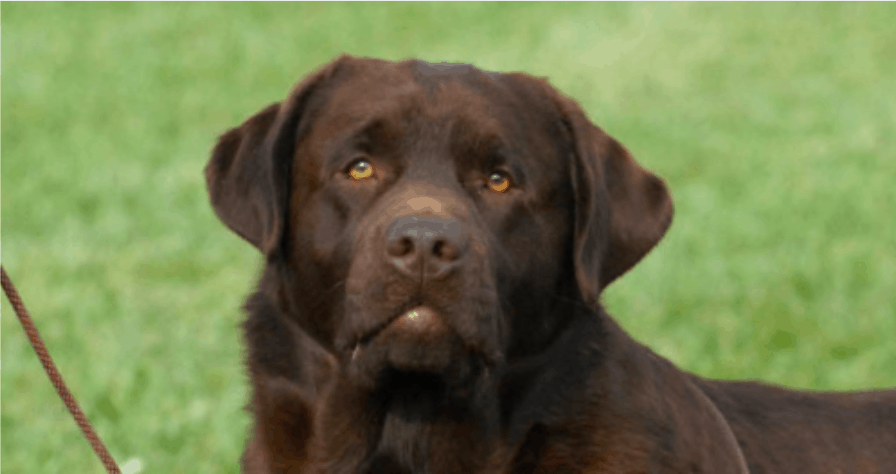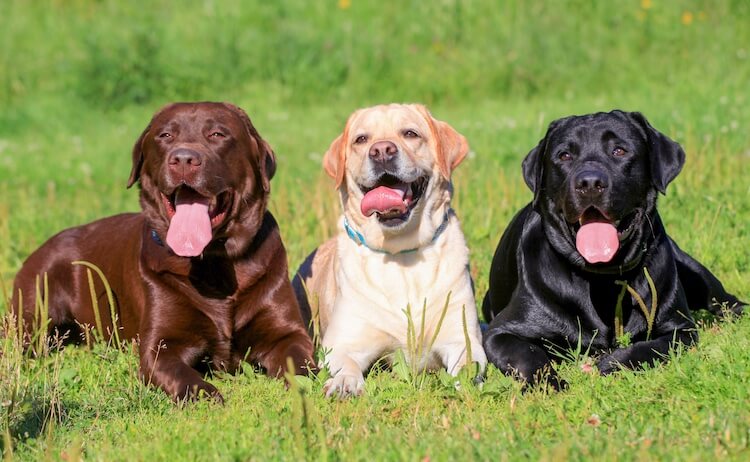A blockhead Lab or block head Labrador is a type of Lab with a broad, square head and a distinctively chunky appearance and is generally classified as English or show-type Labs. Let’s take a closer look at why this is so important for Labrador breeding, and what you can do to ensure that your Labrador has a blockhead look if that is what you desire.
We are going to discuss the controversy surrounding the block head Labrador Retriever and why people care so much about it. And we will look at the risks associated with focusing so much on just one aspect of a dog’s appearance.
Block Head Labs – What Is It?
In this context, the term block head Labrador refers to a type of Labrador, not a description of where they come from! As you can see, English Labradors are also known as conformation Labradors, show Labs, and bench Labs. They are bred to meet the physical ideal of the Labrador breed standard, which has been outlined in the breed standard. Some of the best examples even compete in conformation competitions like the Westminster Dog Show or Crufts.
Is it a Blockhead Lab or a Box Head Lab?
In general, both terms refer to a characteristic physical characteristic of Labradors with English breeding lines. Whoever knows his lab will always be able to understand your meaning, depending on which term is used. However, blockhead is the name that is commonly used.
How do you determine if your Labrador has a blockhead?
Labradors are generally classified into two different types. These two types are referred to by several different names interchangeably. This can be confusing for those who are not familiar with the breed. Here is how Block head Labs fit in:
As the name implies, Labradors bred for their working ability and prowess in field and gundog trials are referred to as American, working, or field Labradors. Although they are popular in America, they are not restricted to the country. Their heads are also a fairly streamlined interpretation of the Labrador breed standard, which indicates that they are slim and relatively light in weight. They also tend to be slim and fairly lightweight in weight.
For instance, English Labradors are bred to match the physical description in the breed standard as closely as possible. This has resulted in several notable physical differences between them and their American counterparts, including a broader head.
In this case, English Labs, which are conformation-type, usually have blockheads, while American Labs, which are working-type, do not usually have blockheads. This doesn’t seem to be a matter of working ability at all, does it? We will examine why the wording in the Labrador breed standard has led to Labs being referred to as blockheaded, as well as why American Labs do not have blockheads.
An overview of Labrador type heads and how to recognize them
According to the breed standard for Labrador Retrievers, the dogs’ heads should be as follows:
“Clean-cut…with a broad back skull and moderate stop; strong, powerful jaws; and kind, friendly eyes expressing character, intelligence, and good temperament.
In light of words such as ‘broad’ and ‘powerful’, it is not hard to understand why dogs with blockier heads have won so many conformation show titles. In addition to having broad skulls, working dogs also tend to have shorter muzzles, and a more prominent stop (the angle at which the muzzle meets the forehead) than working dogs.
The other characteristics of block head Labrador Retrievers are:
There are other signs that an English Lab is what they are known for as well. Here are a few ways to tell if you are looking at an English Lab:
- As a general rule, they tend to be shorter and stockier than their American counterparts.
- In addition, their coats tend to be a little longer and thicker.
- It is more likely that they will still have their otter tail, which is thick at the root and tapers towards the tip. The tail is thought to act as a rudder and to help them swim. It is increasingly missing from American Labradors.
Colors of a Blockhead Labrador Retriever
The American Kennel Club (AKC) accepts Labradors of all types in three standard colors which are:
- Black
- Chocolate
- Yellow
This particular color has been closely associated with the working gundog tradition for a very long time, and the same holds true for a blockhead black Lab. In addition to the blockhead English black Lab, you will also find a blockhead chocolate Lab and a blockhead yellow Lab.
Is it possible for a block head lab to be heavy?
However, it’s important to remember that the American Kennel Club does not officially distinguish between the two types of Labradors. There is also no difference in the size range for English and American Labradors either.
The average weight of a female Labrador is between 55 pounds and 70 pounds while the average weight of a male Labrador is between 65 pounds and 80 pounds. These ranges cover both types of Labradors, but English Labradors tend to weigh at the top end of either scale. It is also known that English Labradors are usually an inch or two shorter than American Labradors as well, so the way they carry their weight makes them appear to have a heavier structure.
In any population, there may be natural outliers. Or in other words, some individuals may be heavier than 80 pounds. It is more likely that puppies whose parents are bigger will grow to be big too.
How Come American Labs Don’t Have Block Heads?
The differences between the two types of Lab exist due to generations of breeders making breeding choices based on slightly different priorities. When breeding English Lab dogs, breeders look for sires and dams that have perfect looks and conformation show titles to continue their breeding line, while American Lab breeders look for dogs that have many field trial champions in their pedigree.
During the past several decades, American Labs have gradually diverged from English Labs in the sense that they are more concerned with working success than a perfect resemblance to the breed standard. These changes include a shift towards slimmer faces with longer, slender muzzles and a less prominent brow. However, both types are still instantly recognizable and equally acceptable as pedigree Lab dogs!
The temperament of an English Blockhead Lab
In addition to the shape of the head of a box-headed Labrador, there is much more to it! English Labs have been said to be calmer and more placid than American Labs. In other words, they do not require as much energy and stamina as working dogs to carry out their functions. To make sure that English Labs are successful at shows, they have to be able to sit around and wait patiently for the next thing to happen. They also have to be unafraid of light, noise, handling, and large crowds of people.
However, the differences between English and American labs are also, to an extent, just generalizations. Both types belong to the same active, energetic breed, and English Labs should still be competent working dogs. It should be noted that block head Labrador Retrievers can still be lively, high-spirited, and tireless, and they need several hours of exercise every day to wear them out! They should also be friendly, devoted, and people-oriented.
What Are The Benefits Of An English Blockhead Lab?
Some people are drawn to a block head Lab vs a regular (American) Lab because they think they are more impressive to look at than a regular (American) Lab. Many people believe that a chocolate Lab from working lines will be calmer and more chilled out than a chocolate Lab from working lines, and they like the idea of a dog that takes less effort to maintain.
English Labradors still need at least two hours of exercise a day, as well as plenty of interaction and mental stimulation. They are best suited to households where there is plenty of time for walks, training, and games. As adults, blockhead Lab puppies can be boisterous and biting at times, but as adults, they are often described as being patient and affectionate with children. Regardless of which type of Labrador you own, puppies are extremely playful, and so if you have enthusiastic teenagers, having a puppy is a great way to keep them occupied.
How to find Block Head Labs that are for sale
You can find large head Labrador puppies for sale by looking for breeders who advertise English Labrador puppies or conformation Labrador puppies for sale. The pedigree for each parent may also show several conformation champions. Show champions are identified by the prefix CH before their registered name. Grand champions are indicated by the prefix GCH.
Also, Pomeranians are one of the most popular dogs in the world, and their popularity means that they come with a high price tag. So, how much does a pomeranian cost? The price of a Pomeranian may vary depending on several factors, such as age, color, and pedigree. However, it can generally cost between $500 to $6,000 to purchase a Pomeranian from a reputable breeder.
Beware of breeders who advertise block head Labs for sale specifically instead of English or conformation Labs. This demonstrates a lack of understanding and knowledge about the breed. It also suggests a preoccupation with breeding exaggerated big head Labrador dogs. A dog with an excessively large head is penalized specifically in the Labrador breed standard.
I believe that the skull should be well developed without being exaggerated. A wedge-shaped head… is not appropriate, nor are massive, cheeky heads.”
Breeding for a single trait can have its risks
It has also been shown that putting too much emphasis on the achievement of a blockhead can have dangerous repercussions for a dog’s overall health. This is in addition to dangerous repercussions. In the case of naive or unscrupulous breeders who wish to breed puppies with very boxy heads, they might choose sires and dams based solely on their head shape. They might even forego health testing, or ignore poor health test results. They may even choose dogs who have poor temperaments. It may end up that their puppies end up looking the way they want, but they may also end up with heartbreaking or expensive health issues, or behavioral problems which are extremely difficult to resolve.
Make sure your dog has regular vaccinations.
You might not be aware of this but blockheads have a lot of genetic diseases, which can cause serious health issues if left untreated. You can also take your dog on a walk so that he can get acquainted with other dogs.
To be able to train your Blockhead, you need to make sure that you have a healthy diet. For this dog to function properly, he needs food rich in protein, vitamins A and B, and high doses of vitamin C. He also needs plenty of water to maintain his bodily functions. The best thing you can do in puppy training is to never punish your dog for doing something wrong. Punishment will only lead the dog to believe that what he has done is wrong, thus causing him to act defensively.
Your Blockhead can be trained as an obedient dog by giving him a command. For instance, you can teach him to sit or lay down if you teach him to sit on your command. You will have to get familiar with your dog so that you can give him the command at the proper time.
You should not forget to provide plenty of toys for your dog to play with. This will help your dog to relieve stress and thus, he will become a happier dog.
Blockhead Labrador Retriever Life Stages
A blockhead Labrador belongs to the group of large and bulky dogs known as bulldogs. Their heads are usually square in shape and broader in front, giving them the appearance of a bulldog that is defending. It is their body structure that makes them different from other dog breeds.
Although the appearance of the dog has remained largely the same, the true nature of the breed has greatly changed over the years. Blockheaded Labrador Retrievers have been most commonly associated with this specific breed trait since this is a very early appearance of the Labrador breed in general.
In the past, Block head Labradors were bred merely for sporting purposes. The animals were then used as gun dogs and to hunt small animals for food. As a result of their sporting backgrounds, the dogs developed the habit of closing their mouths around the objects they were handling or hunting.
The blockheads developed such tightly wrapped heads that even their snouts had a sensitive tip. This made the ideal environment for a dog to protect itself while hunting or protecting property – but it also created serious health and behavioral problems for them.
Hunting wasn’t popular in America until after World War II.
In the early days of hunting, dogs that could be used as hunting aids were usually pointers or back hounds. As hunting became more popular, so did breeds of dogs that were used. Long-tailed or box-shaped labradors evolved to become known as “blockhead” dogs.
The most distinctive feature of block head labs is that their heads are extremely triangular in shape, or box-shaped. Their snouts are short and wide and resemble those of a ham or a scallop. Blockhead labs have naturally short, square tails, but they may be cropped or cut.
The second characteristic of the Labrador is its distinctive double coat. This double coat is called a “shore coat,” and it is a natural feature of this breed. A Blockhead pup has only one undercoat, whereas all other Labrador puppies have two coats – one thick and one thin.
They were bred to be friendly, gentle, and to respond well to human companionship. In fact, some English Labrador Retriever breeders believe that the original intention of breeding these dogs was not to create a sporting breed but rather a companion dog.
Because both the French and the English used the same breed of dog as a fighting dog, there was confusion as to which breed was originally intended when these dogs were bred in England. As a result, the American Kennel Club (AKC) reclassified the English bulldog as the “Bite” rather than the “Bulldog” as a result of this.
American Labrador Retrievers are divided into four types by the American Kennel Club: Barbets, Burmese, Boston Terriers, and Cairn Terriers.
The majority of Labrador dogs in the U.S. were bred to be long-haired, however, there was some crossbreeding with curly-haired Labradors that gave rise to short-haired dogs. In the United States, the word “labrador” refers only to the Maine Coon, rather than to any of its subspecies.
As a matter of fact, the breed’s most distinctive characteristic is the wide, blocky head with its long, floppy ears. This breed does not have a genetic predisposition to blockiness, which is an inherited trait, but rather a combination of genetic characteristics. Blockheads do not have muzzles, and since their snouts are so large, they tend to breathe through their mouths. Blockheads are prone to yelling when they hear something startling near them, and they tend to move around a lot when they are awake.
The blockhead was originally bred in the United States but was introduced to the Australian native species due to their aggressive behavior toward other animals (especially other dogs), which had a much different life span and handling requirements than the American version due to its aggressive behavior towards other animals (especially other dogs). This has resulted in the American Kennel Club re-excluding the blockheaded from their registry as a result.
They preferred a dog with a short muzzle that was straight at the muzzle and gradually slimmer toward the nose, as well as a medium-length, firm chest that was square at the top of a medium-length and firm chest. It is because of this characteristic that the American Labrador Retriever breed standard still calls for a square head shape. Nowadays, nearly all American Labrador Retrievers are black, even though the original black pigment has almost disappeared.
In conclusion,
As its name implies, Blockhead Labs are Labradors from conformation or show-type breeding lines, but they don’t have to come from England. They are also referred to as English Labs, although they don’t have to come from England. Blockhead Labs have broader heads than dogs from working lines, with shorter muzzles and a more pronounced brow bone. Moreover, their entire body is also broader and stockier than other Labs with the same type of face. Block head Labs may seem more laid back than working Labs with more streamlined faces. However, this is a generalization that does not always true. If you are in the market for a labrador puppy at the moment, you should look for breeders who prioritize the health and temperament of the puppy. Avoid breeders who compromise these things to achieve a particular look.
There isn’t actually a special type of Labrador that is known as a Drakeshead Lab. Drakeshead is actually just a British Labrador Kennel name. The Drakeshead Kennel is a famous kennel in England that breeds and competes (very successfully) working type Labradors. They also export Labradors to other countries.



